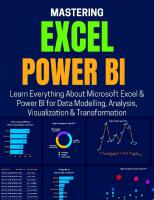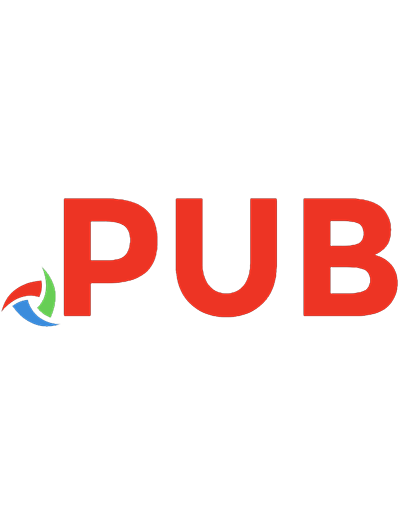Data Analytics & Visualization All-in-One For Dummies 9781394244102, 9781394244096, 9781394244119
Install data analytics into your brain with this comprehensive introduction Data Analytics & Visualization All-in-On
124 94 27MB
English Pages 832 Year 2024

Table of contents :
Cover
Table of Contents
Title Page
Copyright
Introduction
About This Book
Foolish Assumptions
Icons Used in This Book
Beyond the Book
Where to Go from Here
Book 1: Learning Data Analytics & Visualizations Foundations
Chapter 1: Exploring Definitions and Roles
What Is Data, Really?
Discovering Business Intelligence
Understanding Data Analytics
Exploring Data Management
Diving into Data Analysis
Visualizing Data
Chapter 2: Delving into Big Data
Identifying the Roles of Data
What’s All the Fuss about Data?
Identifying Important Data Sources
Role of Big Data in Data Science and Engineering
Connecting Big Data with Business Intelligence
Analyzing Data with Enterprise Business Intelligence Practices
Chapter 3: Understanding Data Lakes
Rock-Solid Water
A Really Great Lake
Expanding the Data Lake
More Than Just the Water
Different Types of Data
Different Water, Different Data
Refilling the Data Lake
Everyone Visits the Data Lake
Chapter 4: Wrapping Your Head Around Data Science
Inspecting the Pieces of the Data Science Puzzle
Choosing the Best Tools for Your Data Science Strategy
Getting a Handle on SQL and Relational Databases
Investing Some Effort into Database Design
Narrowing the Focus with SQL Functions
Making Life Easier with Excel
Chapter 5: Telling Powerful Stories with Data Visualization
Data Visualizations: The Big Three
Designing to Meet the Needs of Your Target Audience
Picking the Most Appropriate Design Style
Selecting the Appropriate Data Graphic Type
Testing Data Graphics
Adding Context
Book 2: Using Power BI for Data Analytics & Visualization
Chapter 1: Power BI Foundations
Looking Under the Power BI Hood
Knowing Your Power BI Terminology
Power BI Products in a Nutshell
Chapter 2: The Quick Tour of Power BI
Power BI Desktop: A Top-Down View
Services: Far and Wide
Chapter 3: Prepping Data for Visualization
Getting Data from the Source
Managing Data Source Settings
Working with Shared versus Local Datasets
Storage and Connection Modes
Data Sources Oh My!
Cleansing, Transforming, and Loading Your Data
Chapter 4: Tweaking Data for Primetime
Stepping through the Data Lifecycle
Resolving Inconsistencies
Evaluating and Transforming Column Data Types
Configuring Queries for Data Loading
Resolving Errors During Data Import
Chapter 5: Designing and Deploying Data Models
Creating a Data Model Masterpiece
Managing Relationships
Arranging Data
Publishing Data Models
Chapter 6: Tackling Visualization Basics in Power BI
Looking at Report Fundamentals and Visualizations
Choosing the Best Visualization for the Job
Chapter 7: Digging into Complex Visualization and Table Data
Dealing with Table-Based and Complex Visualizations
Using AI Tools to Create Questions and Answers
Formatting and Configuring Report Visualizations
Diving into Dashboards
Chapter 8: Sharing and Collaborating with Power BI
Working Together in a Workspace
Slicing and Dicing Data
Troubleshooting the Use of Data Lineage
Datasets, Dataflows, and Lineage
Defending Your Data Turf
Book 3: Using Tableau for Data Analytics & Visualization
Chapter 1: Tableau Foundations
Understanding Key Tableau Terms
Getting to Know the Tableau Product Line
Choosing the Right Version
Knowing What Tools You Need in Each Stage of the Data Life Cycle
Understanding User Types and Their Capabilities
Chapter 2: Connecting Your Data
Understanding Data Source Options
Connecting to Data
Setting Up and Planning the Data Source
Relating and Combining Data Sources
Working with Data Relationships
Joining Data
Chapter 3: Diving into the Tableau Prep Lifecycle
Dabbling in Data Flows
Saving Prep Data
Chapter 4: Advanced Data Prep Approaches in Tableau
Peering into Data Structures
Structuring for Data Visualization
Normalizing Data
Chapter 5: Touring Tableau Desktop
Getting Hands-On in the Tableau Desktop Workspace
Making Use of the Tableau Desktop Menus
Tooling Around in the Toolbar
Understanding Sheets versus Workbooks
Chapter 6: Storytelling Foundations in Tableau
Working with Dashboards
Creating a Compelling Story
Chapter 7: Visualizing Data in Tableau
Introducing the Visualizations
Converting a Visualization to a Crosstab
Publishing Visualizations
Chapter 8: Collaborating and Publishing with Tableau Cloud
Strolling through the Tableau Cloud Experience
Evaluating Personal Features in Tableau Cloud
Sharing Experiences and Collaborating with Others
Book 4: Extracting Information with SQL
Chapter 1: SQL Foundations
SQL and the Relational Model
Sets, Relations, Multisets, and Tables
Functional Dependencies
Keys
Views
Users
Privileges
Schemas
Catalogs
Connections, Sessions, and Transactions
Routines
Paths
Chapter 2: Drilling Down to the SQL Nitty-Gritty
Executing SQL Statements
Using Reserved Words Correctly
SQL’s Data Types
Handling Null Values
Applying Constraints
Chapter 3: Values, Variables, Functions, and Expressions
Entering Data Values
Working with Functions
Using Expressions
Chapter 4: SELECT Statements and Modifying Clauses
Finding Needles in Haystacks with the SELECT Statement
Modifying Clauses
Chapter 5: Tuning Queries
SELECT DISTINCT
Temporary Tables
The ORDER BY Clause
The HAVING Clause
The OR Logical Connective
Chapter 6: Complex Query Design
What Is a Subquery?
What Subqueries Do
Using Subqueries in INSERT, DELETE, and UPDATE Statements
Tuning Considerations for Statements Containing Nested Queries
Tuning Correlated Subqueries
UNION
INTERSECT
EXCEPT
Chapter 7: Joining Data Together in SQL
JOINS
ON versus WHERE
Join Conditions and Clustering Indexes
Book 5: Performing Statistical Data Analysis & Visualization with R Programming
Chapter 1: Using Open Source R for Data Science
Downloading Open Source R
Comprehending R’s Basic Vocabulary
Delving into Functions and Operators
Iterating in R
Observing How Objects Work
Sorting Out R’s Popular Statistical Analysis Packages
Examining Packages for Visualizing, Mapping, and Graphing in R
Chapter 2: R: What It Does and How It Does It
The Statistical (and Related) Ideas You Just Have to Know
Getting R
Getting RStudio
A Session with R
R Functions
User-Defined Functions
Comments
R Structures
for Loops and if Statements
Chapter 3: Getting Graphical
Finding Patterns
Doing the Basics: Base R Graphics, That Is
Chapter 4: Kicking It Up a Notch to ggplot2
Histograms
Bar Plots
Dot Charts
Bar Plots Re-revisited
Scatter Plots
Scatter Plot Matrix
Box Plots
Book 6: Applying Python Programming to Data Science
Chapter 1: Discovering the Match between Data Science and Python
Creating the Data Science Pipeline
Understanding Python’s Role in Data Science
Learning to Use Python Fast
Working with Python
Using the Python Ecosystem for Data Science
Chapter 2: Using Python for Data Science and Visualization
Using Python for Data Science
Sorting Out the Various Python Data Types
Putting Loops to Good Use in Python
Having Fun with Functions
Keeping Cool with Classes
Checking Out Some Useful Python Libraries
Chapter 3: Getting a Crash Course in Matplotlib
Starting with a Graph
Setting the Axis, Ticks, and Grids
Defining the Line Appearance
Using Labels, Annotations, and Legends
Chapter 4: Visualizing the Data
Choosing the Right Graph
Creating Advanced Scatterplots
Plotting Time Series
Plotting Geographical Data
Visualizing Graphs
Index
About the Authors
Advertisement Page
Connect with Dummies
End User License Agreement









